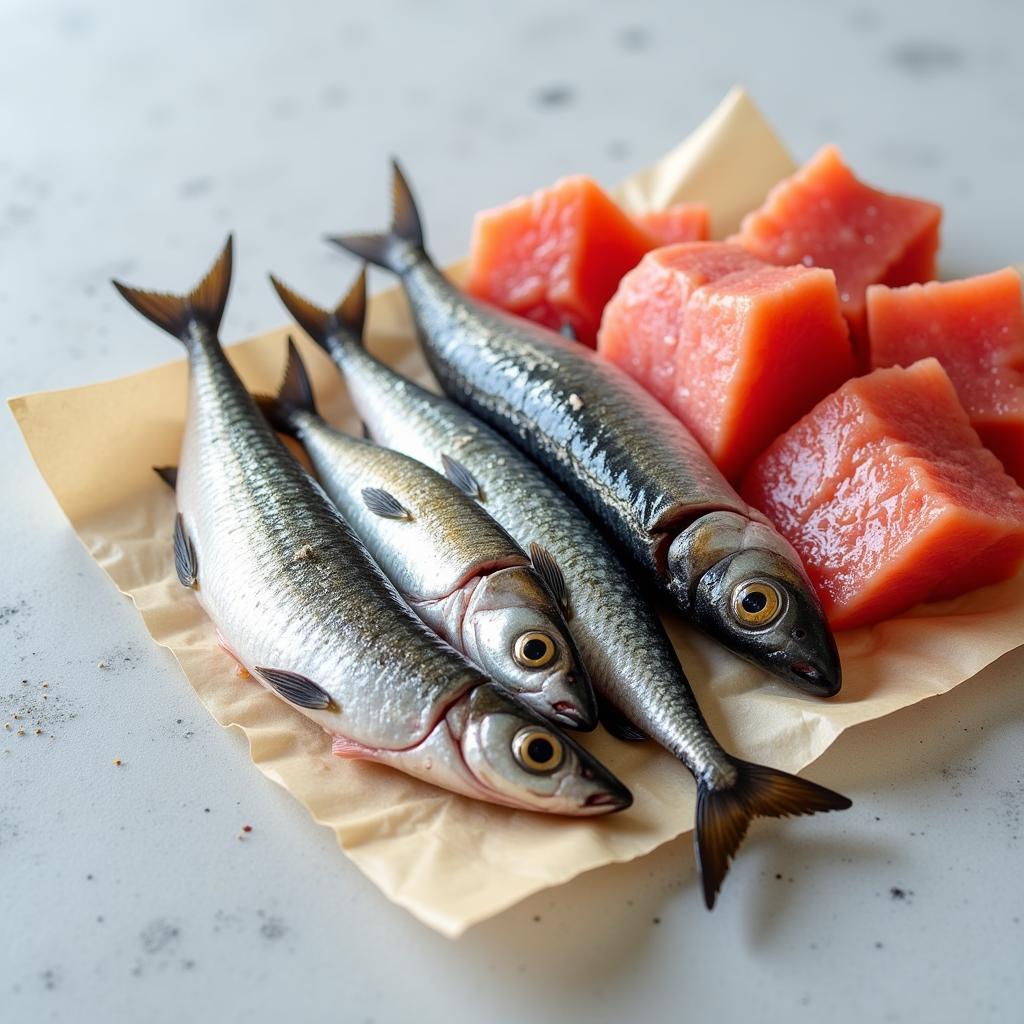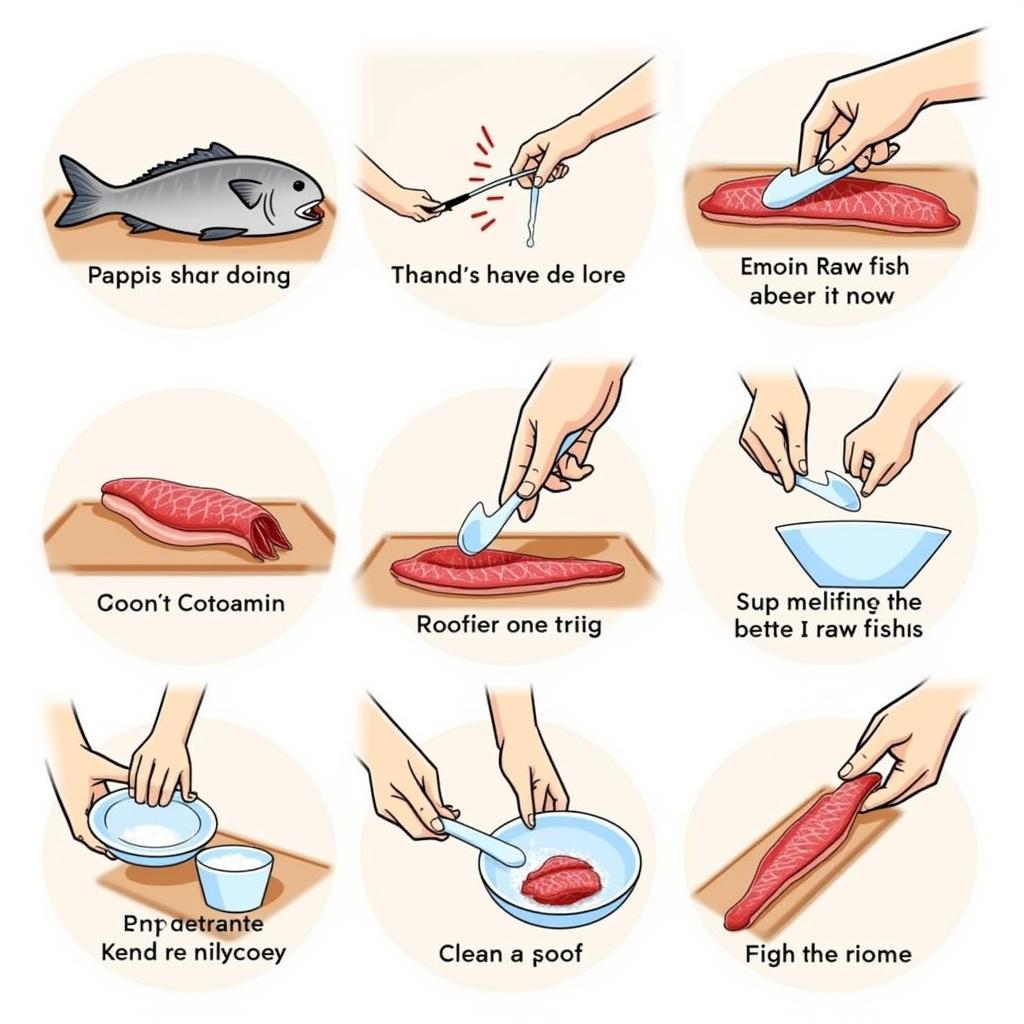Raw Fish Dog Food has become a popular topic among pet owners seeking natural and wholesome diets for their furry companions. This article explores the benefits, risks, and practicalities of incorporating raw fish into your dog’s meal plan. We’ll delve into essential aspects of this feeding approach, addressing common concerns and providing you with the information you need to make informed decisions about your dog’s health. Learn how to navigate this dietary option safely and effectively.
Is Raw Fish Good for Dogs? Unveiling the Nutritional Powerhouse
Raw fish, when prepared and sourced correctly, can be a valuable addition to a dog’s diet. It offers a rich source of omega-3 fatty acids, crucial for maintaining healthy skin, coat, and joint function. These essential fats also contribute to cognitive health and can reduce inflammation. Additionally, raw fish provides high-quality protein, essential amino acids, and vitamins like D and B12. However, introducing raw fish into your dog’s diet should be done cautiously and with proper knowledge.
Are you looking for ways to enhance your dog’s current food? Check out our dog food topper powder.
Potential Risks of Raw Fish for Dogs: Navigating the Dangers
While raw fish offers numerous benefits, it also carries potential risks. One major concern is the presence of parasites and bacteria like Salmonella and Listeria. These pathogens can cause illness in both dogs and humans. Another potential hazard is thiaminase, an enzyme found in some fish species that can destroy thiamine (vitamin B1) in a dog’s system. Thiamine deficiency can lead to neurological problems and other serious health issues. Choosing the right types of fish and preparing them correctly is crucial to minimize these risks.
Choosing the Right Fish for Your Dog: A Guide to Safe Selections
Not all fish are created equal when it comes to canine consumption. Fatty fish like salmon, tuna, mackerel, and sardines are excellent sources of omega-3s. However, larger predatory fish like tuna can contain higher levels of mercury, which can accumulate in a dog’s body over time and cause health problems. Smaller, oily fish are generally considered safer and more nutritious. Avoid feeding your dog raw salmon from the Pacific Northwest due to the risk of parasite transmission.
 Selecting Safe Raw Fish for Dogs
Selecting Safe Raw Fish for Dogs
Preparing Raw Fish for Dogs: Safe Handling and Storage Techniques
Proper handling and preparation are essential to minimize the risks associated with raw fish. Freezing fish for a week at -4°F (-20°C) can kill some, but not all, parasites. Always source fish from reputable suppliers who follow strict hygiene standards. Thoroughly wash your hands and all utensils used in preparation. Never feed your dog spoiled or rotten fish. Thaw frozen fish completely in the refrigerator before serving.
You can find more information on balanced dog nutrition by exploring n&d ocean dog food.
How Much Raw Fish Should I Feed My Dog? Balancing the Diet
The amount of raw fish you should feed your dog depends on several factors, including their size, age, activity level, and overall health. Consult with your veterinarian to determine the appropriate portion size and frequency for your dog’s specific needs. Raw fish should not be the sole component of a dog’s diet. It’s crucial to ensure your dog receives a balanced diet that meets all their nutritional requirements.
 Preparing Raw Fish for Dogs Safely
Preparing Raw Fish for Dogs Safely
How to Introduce Raw Fish to Your Dog’s Diet: A Gradual Approach
Introduce raw fish gradually to your dog’s diet to monitor for any adverse reactions. Start with small amounts and observe for any signs of digestive upset, allergies, or other issues. If your dog experiences any negative effects, discontinue feeding raw fish and consult with your veterinarian.
Looking for other options to diversify your dog’s meals? Consider our food patties.
Raw Fish Dog Food: Expert Insights and Recommendations
“When introducing raw fish to a dog’s diet, start slowly and monitor closely for any adverse reactions,” advises Dr. Emily Carter, DVM, a leading veterinary nutritionist. “It’s essential to prioritize food safety and hygiene to minimize the risks associated with raw feeding.”
“Choosing the right type of fish is crucial,” adds Dr. Sarah Miller, PhD, a canine nutrition specialist. “Smaller, oily fish are generally safer and offer a wealth of nutritional benefits.”
 Dog Enjoying Raw Fish
Dog Enjoying Raw Fish
Raw Fish Dog Food: Conclusion
Raw fish dog food can be a beneficial addition to a canine diet when implemented responsibly. Understanding the potential risks and following safe handling practices are essential for maximizing the nutritional benefits while minimizing potential harm. By working closely with your veterinarian and prioritizing food safety, you can confidently explore the world of raw fish and make informed choices to support your dog’s overall health and well-being. Remember to always source high-quality fish, prepare it correctly, and incorporate it as part of a balanced diet.
Are you looking for a specific brand of dog food? You might be interested in hound dog dog food.
FAQ
- Can puppies eat raw fish?
Yes, but with extra caution due to their developing immune systems. Consult your vet. - What are signs of a fish allergy in dogs?
Itching, skin redness, vomiting, and diarrhea are common signs. - Can I mix raw fish with kibble?
Yes, but introduce gradually to avoid digestive upset. - Is frozen fish as good as fresh fish for dogs?
Yes, freezing can help kill some parasites, but not all. - How often can I feed my dog raw fish?
Consult with your vet to determine the appropriate frequency. - Are fish bones safe for dogs?
Small, soft bones are generally okay, but larger bones pose a choking hazard. - What are some alternatives to raw fish for omega-3s?
Fish oil supplements and flaxseed oil are good alternatives.
Need further assistance? Please contact us at Phone: 02437655121, Email: [email protected] Or visit us at: 3PGH+8R9, ĐT70A, thôn Trung, Bắc Từ Liêm, Hà Nội, Việt Nam. We have a 24/7 customer service team.